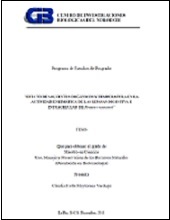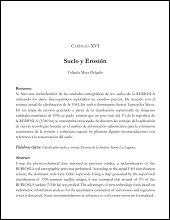Efecto de solventes orgánicos y temperatura en la actividad enzimática de las lipasas digestiva e Intracelular de Penaeus vannamei
Texto completo PDF:
Autor
CLAUDIA IVETTE MAYTORENA VERDUGO
Metadatos
Mostrar el registro completo del ítemResumen
"El estudio de las reacciones enzimáticas, en general, es en medio acuoso. Algunas enzimas pueden mantener actividad catalítica en medios no acuosos, como por ejemplo en solventes orgánicos. Las reacciones enzimáticas en este tipo de medios mejora la solubilidad de sustratos no polares, la recuperación de productos en la fase orgánica, disminuye la desnaturalización por temperatura y da la posibilidad de llevar a cabo reacciones termodinámicamente imposibles en soluciones acuosas. Las lipasas (EC 3.1.1.3, triacilglicerol hidrolasas) son enzimas que hidrolizan el enlace éster de triacilglicéridos para liberar ácidos grasos y glicerol. Para que las lipasas puedan hidrolizar el sustrato necesita darse una emulsión entre los lípidos y el agua para que un dominio hidrofóbico que cubre el sitio activo se desplace y los residuos de aminoácidos que conforman el sitio activo queden expuestos para ligar el sustrato e hidrolizar el enlace éster por un fenómeno llamado activación interfacial. Las lipasas digestiva e intracelular de camarón blanco Penaeus vannamei pueden hidrolizar triacilglicéridos de cadena corta y larga, teniendo preferencia por sustratos con insaturaciones. En este trabajo se estudió el efecto de solventes orgánicos en la actividad enzimática de estas lipasas y el efecto que tienen los solventes en la estabilidad térmica de estas enzimas para poder proponerlas como biocatalizadores para aplicaciones biotecnológicas. Se encontró un aumento de hasta 125 y 225% en la actividad relativa de la lipasa digestiva incubada en 10 y 20% de metanol y hexano respectivamente. En acetona, etanol, propanol y dimetil sulfóxido, la actividad relativa disminuyó al aumentar la concentración de estos solventes y se abolió totalmente en butanol. Al incubar la lipasa intracelular en propanol, la actividad relativa disminuyó conforme aumentó la concentración de solvente en la mezcla. Con metanol, etanol, acetona, butanol, dimetil sulfóxido y hexano mantuvo hasta 38% de su actividad enzimática. La lipasa intracelular mostró mayor estabilidad en solventes orgánicos, a excepción de propanol. Al incubar las lipasas de camarón en 10 a 40% metanol y temperaturas mayores a la óptima, la lipasa digestiva aumentó 40% su actividad relativa y la lipasa intracelular hasta 5 veces en 20% de metanol..." "Most of the studies of enzymatic reactions are in aqueous media, but some enzymes can work in non-aqueous media, like in organic solvents. Some advantages of carrying out reactions in non-aqueous media are: a) Better solubility of non-polar substrates, b) Product recovery in the organic phase, c) Improvement of thermostability. Lipases (EC 3.1.1.3, Triacylglycerol hydrolases) are the enzymes responsible of the hydrolysis of triacylglycerides, releasing fatty acids and glycerol. The reaction takes place only when an emulsion is formed between lipids and water; a hydrophobic domain covering the active site will be displaced, and the enzyme is able to hydrolyze ester bonds by a phenomenon called interfacial activation. It has been proved that shrimp lipases can hydrolyze short and long acyl chains triacylglycerids, with preference for long polyunsaturated acyl chains. The aim of this study was to search for new characteristics of these lipases for potential biotechnological applications, studying the effect of organic solvents in the enzyme activity and the ability of solvents to improve the thermal stability of these enzymes. The relative activity of digestive lipase exhibited an increase of125 and 225% in the presence of methanol and hexane. Relative activity decreased in the presence of acetone, ethanol, propanol and dimethyl sulfoxide, as solvents concentrations increased and in butanol, enzyme activity was abolish. Intracellular lipase activity decreases its relative activity in propanol. In methanol, ethanol, acetone, butanol, dimethyl sulfoxide and hexane, intracellular lipase activity was stable. When shrimp lipases were incubated in solvents and high temperatures (40 and 50 °C), digestive lipase activity increased 40% in methanol and intracellular lipase five fold. It was concluded that the accessible surface area determines the interaction between lipases and polar organic solvents given the structural differences between lipases of other species and the probability of water molecules interact with the protein."
Colecciones
Ítems relacionados
Mostrando ítems relacionados por Título, autor o materia.
-
PROMOCIÓN DEL PERIFITON PARA EL CULTIVO DE CAMARÓN BLANCO: HACIA UNA ACUICULTURA ECOLÓGICA
DOMENICO VOLTOLINA LOBINA; JUAN MANUEL AUDELO NARANJO; MARIA DEL ROSARIO PACHECO MARGES -
Suelo y Erosión
YOLANDA LOURDES MAYA DELGADO


